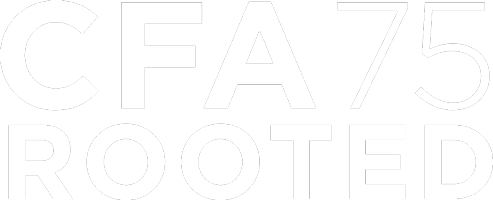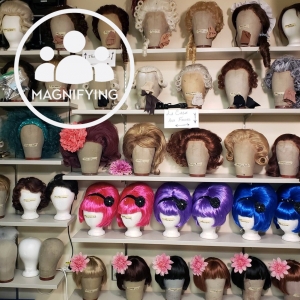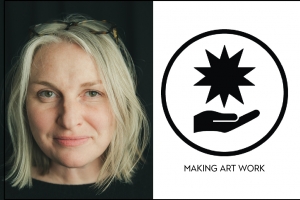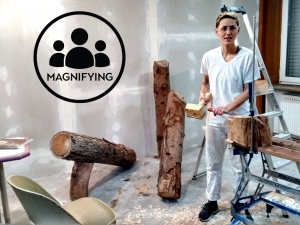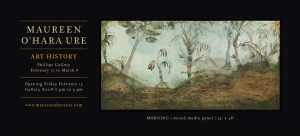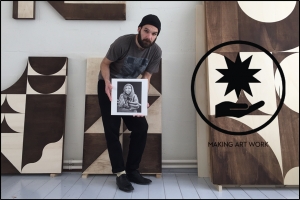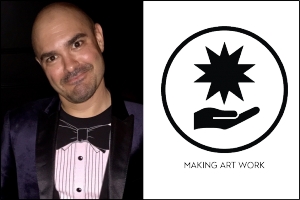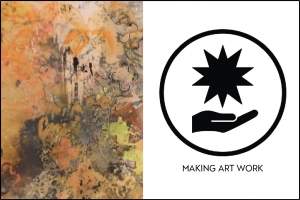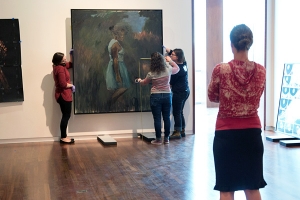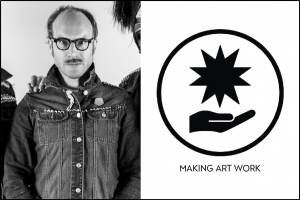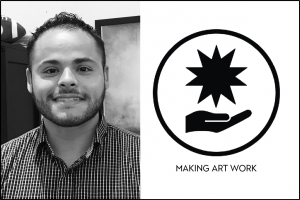Displaying items by tag: Artist
MAGNIFYING, No. 20: Amanda French
By Noelle Sharp
For this episode of MAGNIFYING we spoke with Wig Master, Hair and Makeup Designer for Pioneer Theatre Company and the Department of Theatre, and Adjunct Assistant Professor for the Department of Theatre Amanda French. Our creative community here at the College of Fine Arts is diverse and wide spread. With the goal of gaining a deeper knowledge and awareness of the people within our community, we bring you MAGNIFYING, a series dedicated to showcasing the talent of our students, faculty, and staff.
Tell us about yourself: Name, where you are from, what you do and how you got into in your field of work
My name is Amanda French and I am originally from Cincinnati, Ohio. I am the Wig Master and Hair and Makeup Designer for Pioneer Theatre Company and the Department of Theatre, and Adjunct Assistant Professor for the Department of Theatre teaching stage makeup classes, and classes in all aspects of wig and makeup design.
I construct and style all of the wigs and facial hair for all Pioneer Theatre productions and for the 4 mainstage productions for the department of theatre. I make sure that all of the performers know how to do their own makeup for the productions, including instruction as needed. I have also done prosthetics for productions, including the severed head for Macbeth, the nose and mouth pieces for the Beast in Beauty and the Beast, and Cyrano’s nose in Cyrano de Bergerac. I have been at Pioneer and the University since 2003, and have worked on over 200 productions in that time.
My path to this job has been quite varied, and this is the short version: In high school I wasn’t the best academic student, but enjoyed my time in 3 different choirs, and marching and concert band. I was never a part of the drama club, but did enjoy being in the chorus of Guys and Dolls my senior year. At the time, a career in theater was never on my radar. My first year in college I studied music education and voice, then when my family moved to Pennsylvania, I went to a community college where I took acting classes, and joined a swing choir. I did a small amount of acting and helped backstage doing props, and sound, then found my way to a stage makeup class – which I loved. A couple of summers I worked as an assistant stage manager for a small community theater, and decided that I loved working backstage and needed to focus on that work. I applied to and then attended the University of Cincinnati – College Conservatory of Music (CCM) from 1986-1990 where my major was in design and technical theater with an emphasis in wigs and makeup. I continued to work as an assistant stage manager (ASM) and did a couple of internships with Cincinnati Playhouse in the Park. By the time I left CCM in 1990, I was working professionally as an ASM, and when I wasn’t doing that, I was doing wigs and makeup. In 1992 I decided to focus on wigs and makeup, got a job teaching at The School for Creative and Performing Arts in Cincinnati, and never looked back. I have been blessed with a 30 year career doing what I love.
What has surprised you the most in your life?
What has surprised me the most is how important teaching has become to me. There have been several articles in the New York Times in the last couple of years that talk about wig making becoming a dying art as some of the best in the business in the US, like Mr. Paul Huntley in New York, get closer to retirement. However, the author of the article neglected to look outside of the city, to find out how many great wig masters and wig artists there are in the Regional Theater world, and working for professional touring companies all over the country. There are very few schools that have wig and makeup design as an emphasis or major, and it is very important to keep this field supported. Being a wig maker is a job that has existed since at least the time of the Egyptians, and isn’t going any where soon, but we need more active professionals to teach the very specific skill sets that are required for building wigs. This is not a skill set that is taught in beauty schools at all, and more universities need to include it as a major in their technical theater departments, taught by working professional wig masters.
What do you wish you had known/been told?
I was actually warned several times that it is hard to make money in live theater. Most of my classmates went into film and television, and I am one of the few who chose to stay in live theater. I wish that I had learned more about the business side of show business and that I had reached out to more professionals in the field for guidance, early in my career. But then, that was before the days of the internet, and it is much easier now!
MAKING ART WORK, No.16: Amy Jorgensen
By Noelle Sharp
MAKING ART WORK: Advice for artists, from artists is a series that taps into the knowledge and experience of seasoned creatives from our community and beyond for the benefit of our students. We had the pleasure of speaking with maker, facilitator, educator and Executive Director and Chief Curator at Granary Arts Amy Jorgensen for this episode of MAKING ART WORK.
What do you wish you had known when you were a less experienced artist?
• Don’t be a student. Students work for grades and approval within systems. Free yourself from the mindset of the student identity. Every assignment has the potential to turn into a life-long project. Work for yourself.
• Mistakes are part of the process. Nothing goes perfectly the first time. Build re-dos into the timeline.
• There are many trajectories and no single right way forward.
• Work your chops. Learn the technical skillset and language of your medium.
• Be proactive. If you are not getting what you need, ask for it. Opportunity is everywhere, it’s up to you to act on it.
• Take risks. Understand your boundaries and reach beyond your safety zone, your creative life depends on it.
How do you find balance between creating your own art and using your creative talents for other projects (jobs, collaborations, etc.)?
I don’t really subscribe to the notion of balance. I’m all in. And I’ve found the more time, effort, and resources I pile into the mix, the more rich, saturated, complicated, big, and overwhelming this art making world becomes. It’s just starting to get interesting. The challenge of balancing personal creative practice with day jobs, collaborations, and life will always be present. Set priorities and boundaries where you must. Clear out the superfluous stuff that doesn’t matter. And find the time to support good projects and people that champion generosity and are working towards a vision you believe in.
What’s the most useful advice you were given?
• Read, write, think, dream. – John Baldesarri
• Safety is an illusion. – Amy Jorgensen (advice learned from life)
• Just do it. – Nike slogan
MAGNIFYING, No. 19: Kelsey Harrison
By Noelle Sharp
For this episode of MAGNIFYING we spoke with Department of Art & Art History Assistant Professor Kelsey Harrison. Our creative community here at the College of Fine Arts is diverse and wide spread. With the goal of gaining a deeper knowledge and awareness of the people within our community, we bring you MAGNIFYING, a series dedicated to showcasing the talent of our students, faculty, and staff.
Tell us about yourself: Name, where you are from, what you do and how you got into in your field of work
My name is Kelsey Harrison and I am from the Bay Area in California. I make sculpture and teach in the Sculpture Intermedia area in the Department of Art and Art History. I got into it when, in the transition from middle to high school, technical classes were no longer available and the closest thing was a 3D art class. We worked in ceramic and small metals. I fell in love with the atmosphere and spent nearly every moment, spare or otherwise..., in the Crafts classroom. I studied sculpture in college because I never stopped making sculpture, even when I dabbled in other possible majors in community college.
What has surprised you the most in your life?
Most things, honestly. I didn't have a long-term vision when I was younger. I never expected to be a professor. I never expected to be as professionally oriented and serious as I have been in the last few years. I was a party girl in high school-I won the superlative of "biggest slacker" in our high school year book. When I began taking myself and my abilities seriously, everything began to change and since then every single thing has been a surprise.
What do you wish you had known/been told?
Ambition for its own sake isn't worth much. Ambition should, if you value it, be in relationship to what you love and what makes you happy. In a minor way, I fell into the trap of wanting what I thought I should want, meeting benchmarks of success that were..."natural next steps" in my field rather than setting benchmarks based on making the life I want. Trust yourself and listen to yourself, and center ambitions around what you find when you do. This is something I was told, of course, but I wish I hadn't decided it was a corny platitude. Corny platitudes, as much as they make my skin crawl, have largely proven to be valuable axioms. Your art won't be satisfying to you if you aren't trusting yourself and listening, even if your work is patently not interested in "self-expression" as the highest value.
Maureen O’Hara Ure is a Professor Lecturer at the University of Utah, College of Fine Arts teaching Art 2400 for first year studio majors, Drawing I, and Senior Seminar. She has received many grants in support of her work, including the most recent one from the College of Fine Arts, which helped fund two large projects: "Love & Work", a solo show of paintings, and the publication of an artist’s book. "Seeing and Believing: A Traveler’s Sketchbook", the third volume to appear under her imprint, The Hand in Glove Press, features O’Hara Ure’s responses to the Romanesque art and architecture encountered in central France.
This year Red Butte Press has published "Stranger and Stranger", a bestiary composed of her images and poems by fellow University of Utah professor Katharine Coles, having collaborated for over three decades. O'Hara Ure's next solo exhibit, “Art History,” will open February 15th at Phillips Gallery.
“For almost 20 years, all my major projects have started off with travel, with my drawing in museums and at historical sites overseas. In each case, my travel sketchbooks have focused on pre-Renaissance art and architecture. I have returned to the studio and set about using the raw ideas in the sketchbooks to begin developing new work, feeling free to take liberties with the historical material I collected. Much of the work in “Art History”, my exhibit of new paintings at Phillips Gallery, is narrative. At some point in developing an image, I start to think of this or that beast or landscape as standing in for myself or for a family member in a kind of short story (or poem) that recalls love and loss, joys and sorrows.
Relying on a sturdy panel to hold up to months, sometimes years, of revisions, I slowly build up an image, obsessively laying down marks in thin, sanded layers of paint, ink, and pencil. When a panel returns to my studio from a show, I may begin to tinker with the image, perhaps first sanding out or painting over just a section. Often as not, I keep going and start all over, using gesso to erase any memory I have of the painting. I can see, for example, from my scribbled notes on the back of one of the oldest long panels in “Art History” that I first began to develop its surface in 2007, and three years later judged it finished and included it in my 2010 solo show at Phillips. After beginning to radically revise that painting last summer it is now unrecognizable, and, as “Panorama”, hangs here as part of this new collection.” —Maureen O’Hara Ure
WHERE: Phillips Gallery444 East 200 South Salt Lake City, UT 84111
WHEN: Opening 2/15, Gallery Stroll from 6-9P. The exhibition will be on display from 2/15 to 3/8
MAKING ART WORK, No.15: Louis Reith
MAKING ART WORK: Advice for artists, from artists is a series that taps into the knowledge and experience of seasoned creatives from our community and beyond for the benefit of our students. We had the pleasure of speaking with Dutch artist, Louis Reith, for this episode of MAKING ART WORK.
What do you wish you had known when you were a less experienced artist?
Since I studied graphic design in college and university, I had a particular proces towards my autonomous creative practise. The hands on approach to my work arose from being fed up looking into this light box we call a computer. While in fact desktop publishing is the fundament for the things I create with my hands. In that sense I am thankful for being influenced by the digital while having the tactility of working with paper and other physical materials.
As a child I wanted to be an archaeologist but I turned out to be more of a creative. As a teenager I wanted to be a musician and a DJ but due to a computer crash I lost all my material thus my focus changed towards the record sleeves; graphic design. Nowadays looking for materials - going through books at thrift stores and markets everywhere I go - brings out the archaeologist in me. I don’t have the full equipped music-studio anymore but I still enjoy making loops with drumcomputers and samplers. I collect records and even released some cassettes by others through my publishing house. I recently applied for a woodworking course. Maybe I’ll be a professional joiner in a couple of years. My point is; do what makes you happy.
How do you find balance between creating your own art and using your creative talents for other projects (jobs, collaborations, etc.)?
Even though it’s not accepted by everyone in the art world, I personally enjoy doing commercial projects. Not just in favour of the financial aspect but also the social side. Being an artist can be quite egocentric and lonesome, and to avoid getting an isolated douchebag I collaborate with people and educate young creatives. Working together with others also keeps me up to date and often gives me new insights into my own practise. And with money comes more room for experiment and the ability of taking risks.
Last year a regional poll-outcome stated that 82% of poll takers believe artists should choose another profession if they are not able to live 100% from their art. As if it were comparable to commercial ventures. I believe it’s the economic system that lacks time and space and doesn’t allow people to take risks. Because risk taking is the most important element of progress. I truly think we need to radically change our views on labor in general.
What’s the most useful advice you were given?
A big game-changer happened during my graduation at the art academy, when I made seven books as a catalogue for an exhibition series curated by a friend. She invited me to take part in that particular exhibition and asked me specifically to show merely my graphic design work. That was the turning point, because most artists were related to illustration and painting and it made me aware of new possibilities. Showing printouts of digital works wasn’t an option for me as I wanted to create something unique. That is when I started drawing abstract geometric compositions on old book pages. These compositions are based on words, and function as a coded language, which only I am able to decipher. This concept is still present in my work today.
MAKING ART WORK, No.13: Jeff Dixon
by Noelle Sharp.
MAKING ART WORK: Advice for artists, from artists is a series that taps into the knowledge and experience of seasoned creatives from our community and beyond for the benefit of our students. We had the pleasure of speaking with writer, filmmaker and Film & Media Arts alum, Jeff Dixon, for this episode of MAKING ART WORK.
What do you wish you had known when you were a less experienced artist?
Because this series is called “Making Art Work” I’ll steer this answer toward treating art as a career choice and not simply a hobby. Early in my attempt at an actual writing career, I had tunnel vision focused solely on the craft. I figured all I had to do was write glorious magic, and success would naturally follow. Now I know it was naive to be so one-sided. Obviously the art comes first, no question, but looking back now I wish I’d known more earlier on about the BUSINESS of my art as well. Yep, I know in the art world sometimes the dreaded “B” word gives you shivers, but don’t let it. You can be the single greatest artist in the world, yet if you aren’t business savvy as well, the only people who will ever know your skills will be your mom, your dog and maybe your Aunt Lupita. I wish I would have worked concurrently learning how the business of screenwriting/Hollywood worked at the same time I studied the craft. If you want an actual career out here, you can’t have one without the other. There’s a reason why they call Hollywood, “The Business.”
How do you find balance between creating your own art and using your creative talents for other projects (jobs, collaborations, etc.)?
Balance is key to everything. I’m a dad of two daughters and because my wife’s work has always caused her to travel a lot, I’ve been the primary caregiver at home. For me I had to find balance not only in work, but with family as well. Before I was pretty loosey-goosey with scheduling my time, but I learned early on that I needed structure or I wasn’t going to get anything done. Now I treat writing just like any other job or duty. I schedule dedicated blocks of time in my calendar every single day solely for writing. If I only used my calendar for pitches, meetings, kid’s school scenarios, doctor’s visits, or any of the other 1000 items in a day, I’d never get any actual writing time in there. If I schedule it directly in my calendar, I don’t let anyother distractions get in that time block. Although trust me, I’ll still find some time in there to procrastinate with a little Facebook or Plants vs. Zombies. I am a writer after all.
What’s the most useful advice you were given?
Don’t limit yourself. Make yourself available to work on every single aspect of your craft, and every genre. When I first started I solely considered myself a horror screenwriter. I only wrote films, and I only wrote horror. But over the years, I widened my spectrum and started working not only in all genres, but in all different forms of writing as well. I’ve since written comic books. I’ve published a full graphic novel. I’ve written for video games. I’ve written for TV. I used to write the blog/lesson summaries for the Stan Winston School. Hell, I even wrote for the WWE for a while. Guess what happens when you don’t limit yourself to one aspect? Your craft grows in all aspects. For example, when I was writing for wrestlers in World Wrestling Entertainment, I had to really focus on my dialogue. And not just any dialogue, but short-form dialogue. Live television working in exact blocks of time (as well as the limited vocabulary of a few performers) makes for the need to get the most information out in the shortest amount of time. This ended up helping me with the dialogue in all my feature scripts as well. Every aspect helps the other. Plus, if I would have only stuck with writing horror, I wouldn’t have an action movie like The Hurricane Heist coming out in March! Although, I definitely tried to squeeze a few “horror” moments in there. Can’t take that part away from me.
For more information on Dixon you can follow his blog at here. Make sure to check out Dixon’s film, The Hurricane Heist, coming out on 3/9.
MAKING ART WORK, No.11: Kim Brown
By Noelle Sharp
MAKING ART WORK: Advice for artists, from artists is a series that taps into the knowledge and experience of seasoned creatives from our community and beyond for the benefit of our students. We had the pleasure of speaking with Artist and Department of Art & Art History Alum Kim Brown for this episode of MAKING ART WORK.
What do you wish you had known when you were a less experienced artist?
Don’t wait for inspiration or a really good idea to start to make something. Chuck Close said something about “The work comes from the work. Process, in a sense, is liberating, you don’t have to reinvent the wheel every day”. I work mostly in ceramics and textiles. Both these mediums lend themselves to a lot of surface design and development. When I’m stuck or not satisfied with where a piece is going, I’ll make samples, experiment with techniques or explore risky ideas. This will help generate energy and excitement to move in a new direction.
How do you find balance between creating your own art and using your creative talents for other projects (jobs, collaborations, etc.)?
It’s easy to get distracted with all the demands of life. I try and do my best with limited time for art, my job and other responsibilities. I can get a bit cranky when I don’t get into the studio but sometimes there isn’t room for everything. Here’s another good opportunity to make samples and when my schedule allows, I’m ready and looking forward making my work.
What’s the most useful advice you were given?
U of U professor, John Erickson once said “Blind contour drawing is really good medicine for the brain”.
Keep a sketch book.
Keep working.
Women in Art: Whitney Tassie
Written by Allison Pinegar.
Whitney Tassie is the curator of modern and contemporary art at the UMFA and the woman behind the upcoming exhibition A Fuller Picture: Selections from the Modern and Contemporary Collection for the UMFA’s reopening on August 26, 2017. In preparation for the all-women show, The Finer Points will be highlighting female artists from the UMFA’s collection, the state of Utah, and the University of Utah.
In 2015 Art News reported the statistics of female representation in the art world. The statistics are staggering, revealing that despite recent efforts of art institutions, there is still significant bias. Maura Reilly’s article is partly what inspired Whitney Tassie, the UMFA’s curator of modern and contemporary art, to curate an all-women show for the museum’s reopening in August. “When you see the numbers it’s shocking. The arts are not a particularly stat-heavy industry, it’s fairly unregulated. But when someone takes the time to do that it’s very telling,” Tassie explains. And she’s not wrong – in April 2015 only 7% of the works on display from their permanent collection at the Museum of Modern Art were by women. Reilly’s call to “right the balance” is not off base nor petty.
Tassie’s exhibition, A Fuller Picture: Selections from the Modern and Contemporary Collection will showcase works by female artists from the UMFA’s permanent collection, including both local, national and international artists. Works by names like Yayoi Kusama, Anna Campbell Bliss, Helen Frankenthaler, Jann Haworth, and a new Faith Ringgold acquisition will be on display for two years. The Kusama and Frankenthaler pieces were the first two works Tassie knew needed to be displayed in the new gallery space. From there, she began to consider how these various artists expand the definitions of movements like abstract expressionism, minimalism, and pop art, but also how some of these women defy those categories, complicating the traditional art historical narrative.
While shows featuring only women are gaining popularity, they are still problematic in some sense. “It is a problem that we’ve only seen these women in all-women group shows. Let’s talk about that,” Tassie presses. “It opens myself and the museum up for criticism, but in doing that we start a dialogue and we can talk about the history of exhibitions and of representation of women artists in museum collections.” Acknowledging the “baggage” that comes with doing a show like this offers opportunities for visitors to really consider the role of the museum. To further emphasize these issues, the exhibition will include a reading nook where visitors can learn more about the history of women in the art world and the statistics that prompted Tassie to curate A Fuller Picture.
The UMFA seeks to be a place of inclusion and scholarship, as well as to provide compelling, relevant, and insightful exhibitions for the University and local community. These goals were upheld in the remodel. “The changes we’re making in how visitors engage with the art and the Museum’s unique spaces will make the UMFA more relevant than ever in the lives of our audiences,” UMFA executive director, Gretchen Dietrich said in an April press release. A Fuller Picture encompasses these goals, offering space for patrons to consider why art museums own more art made by men than women, and what it means to be a woman. Tassie states, “I am grateful that the museum can be a platform for these conversations that are feeling ever-more urgent today – a renewed urgency, anyway – to talk about feminism and to try to dispel some of the myths or paint a more inclusive picture of feminism or art history.”
Be sure to catch A Fuller Picture: Selections from the Modern and Contemporary Collection when the UMFA reopens to the public on August 26, 2017. The reopening will include a two-day celebration featuring talks, tours, films, a dance part and more! For additional information about the UMFA, visit UMFA.
MAKING ART WORK, No.6: Mark Jeffery
By Noelle Sharp
MAKING ART WORK: Advice for artists, from artists is a series that taps into the knowledge and experience of seasoned creatives from our community and beyond for the benefit of our students. We had the pleasure of speaking with performance/installation artist, curator and educator, Mark Jeffery, for this episode of MAKING ART WORK.
What do you wish you had known when you were a less experienced artist?
I am coming up to my 44th birthday on May 9th, and am grateful to have been making work for the past 23 years since graduating from Dartington College of Arts in the UK in 1994. As artists we are curious, we are instinctual, and intuitive in how we listen and respond and engage in practice and making. For me my weakness and strength has always been my anxiety that can keep me working but also paralyse me in absolute self doubt. As a young artist and an artist making work today here in Chicago, I wish I could be less afraid and tell my younger self to trust more in your making and to not put so much pressure on myself as the work will make itself and that you will develop and grow from the opportunities you apply for, from the mistakes that you make, from the connections you make and to keep making in a community around you that is supportive. I also think about trusting oneself in making through time. Time is your collaborator and your friend and as you keep making you learn how to keep developing and working on your ideas, some of these ideas and ways of working keep returning and recurring over and over again. I wish now I could realise that sometimes your work can take years to develop, sometimes your ideas don’t have to be developed overnight and that making does not have to be singular and that you can learn to make working with others, you can learn to grow through making your work in different forms and mediums and that sometimes to not be an expert in a medium can be a place of being uncomfortable but also give you a place to keep learning from.
How do you find balance between creating your own art and using your creative talents for other projects (jobs, collaborations, etc.)?
Work is very important to me. Working is very important to me. To work keeps me curious, active and in conversation with others and community that is near and far from me. Working with each other and together is very important to me. I was raised on a dairy farm and I often think of the fields that were connected to each other. Fields that were marked and delineated by hedges that separated one field from another field or one’s field to another farmer's field. In each field there would be different crops growing, or perhaps grass that cows would feed on or perhaps a field that was fallow. It was important to me growing up to walk around these fields and to see the crops grow, rotate and to see how these fields all connected with one another. I am an artist, teacher and curator. All these positions that I work on I think of as fields and each one of them has different sets of concerns and different times when more attention is needed to them. I am someone who can be quick in response to what I see in front of me, but I have discovered that I need slowness to develop ideas and projects and to allow myself to listen to what I am seeing in front of me and that I need to take time to see, to listen and to learn. In my practice, my work with Anatomical Theatres of Mixed Reality (ATOM-r) Performance Group that I co - founded is one of iteration and taking two - three years to develop a work, to be in the rehearsal space twice a week and to focus on each three hour rehearsal with attention and care. This is a field called work and this is a field called play and this is a field of community and this is a field of mistake and iteration and listening and giving voice to collaboration and giving and paying attention. This is also a field of transformation, mistake and failure and this is a field of being present in work and to keep moving. A question then becomes how do you allow the practice of work and attention to be in other fields, of teaching and curating? I think very much about measurements of time and how much we give to what we are doing in a day. I am a full time faculty at the School of the Art Institute of Chicago. Each semester I am contracted to teach 2 classes and also to be the Graduate Coordinator of the Performance Department. I commit also to this time. To be in classroom, like a field for 6 hours each class and also the preparation for this class. I make sure to organise a class like a rehearsal so that each hour, minute is prepared and looked at with attention. In attention I am curious, so in organising my classes I think of them almost like a garden so that there are different plants growing at different times. Different times allows for attention to cross over and to allow for one or more things to take place over the course of a 6 hour class day. This class day then grows over the course of a 15 week semester. Like rehearsal, there is iteration and like rehearsal each member of the class learns to develop their own language and this language is there field that connects to other fields in their lives. Work is a friend I am not afraid of. Work is a stranger that keeps me moving and learning how to grow. Work allows me to meet and engage with voices I never thought I would come into contact with. Work and time teach me how to listen and work with other people and to be in a creative space. Work can also be about taking care of yourself, so what does it mean to also give time in my case to going to the gym or taking time to cook a dinner at home and to also have conversation around the dinner table or to tend your garden at home, spring, summer, fall and winter.
What’s the most useful advice you were given?
As a young student artist in undergraduate school at Dartington College of Arts in the UK I was very shy, nervous and lacked in confidence. I was someone who did not believe in myself and had a lot of doubt. In my three years of study in arts school, there were three women artists in each year who gave the advice that I needed. Sally Morgan in my first year gave me permission to see my work as image making, what can the body say in time and space? What can the physical and emotional body demonstrate through the images that you make. These images came through as actions that would come from writing and drawing. From writing and drawing I would then translate these images into physical actions that were composed in time and space. Before arts school I had come from a two year performing arts school training in dance and theatre. In my self doubt I learnt how to translate the training of being a performer into that of a maker and to create images. In my second year of study at 19, Lin Hixson Performance Artist and Performance faculty at The School of the Art Institute of Chicago was a visiting artist at the school. She told me in watching a work in progress of my work in an advising session that my work was about fear and control and to work towards these words and away from these words and to not be afraid and to listen to your instincts and that the self you are most afraid of is the self that needs the permission to grow. Work and work towards the unknown, walk towards what you don’t know. In my third year I was going to perform my thesis show to National Review of Live Art curator of performance Nikki Milican who had travelled from Glasgow to the south west of England to see student work. I was terrified to perform my work in front of Nikki. In my stubbornness I refused to perform the work. My teacher Sally Tallant then arranged for me to have a one on one meeting with Nikki where I showed Nikki a series of photographs of my performance work that I had made the previous week. Sally insisted that I meet with Nikki. Nikki became the first curator to invite me to present my work as a 21 year old in Glasgow and also suggested from the images that I had shown her to develop the performance into a six hour duration work. These 4 women gave me permission to begin the long process of listening to myself, to my instincts to not being afraid. To believe in the work I make and to believe in working with other people and to walk and to keep moving as you work. As Lin Hixson says, ‘Work towards complexity rather than simplicity and create spaces of attention and commitment. If you commit the audience will stay with you and be in engaged in your work.’
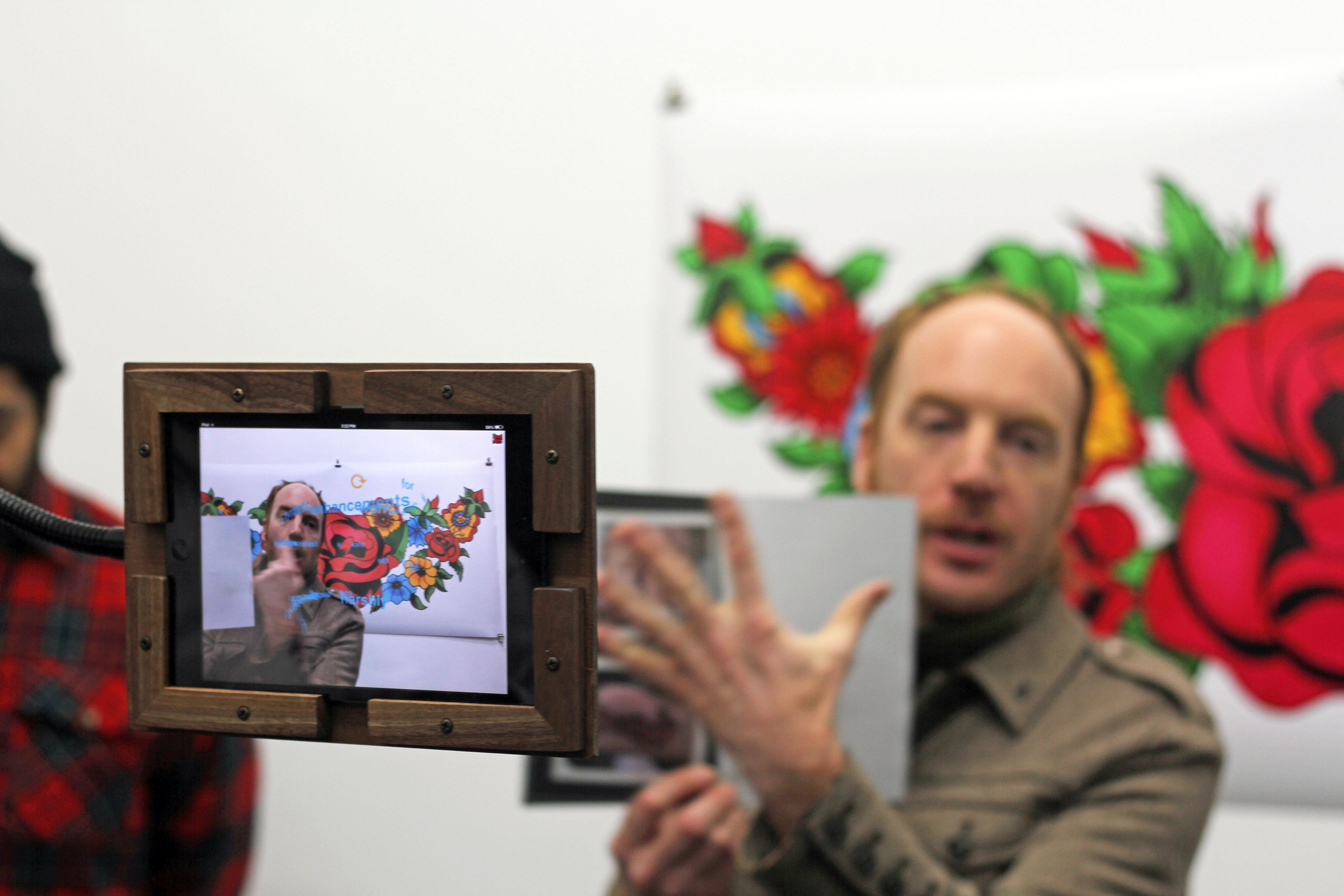
MAKING ART WORK, No.5: Alejandro Melendez
By Noelle Sharp
MAKING ART WORK: Advice for artists, from artists is a series that taps into the knowledge and experience of seasoned creatives from our community and beyond for the benefit of our students. We had the pleasure of speaking with Alejandro Melendez, Director of Development, Unscripted and Featured Documentaries, for this episode of MAKING ART WORK.
What do you wish you had known when you were in school about working as a professional artist?
This is an interesting question, because what I know now all comes from experience on set and in the office. In class you learn a lot about theory and techniques which is great to know. However, depending on the track you want to follow most of what you learn in class will serve as great dinner conversations about the composition and structure of Citizen Cane, it will not get you a job. If you want to surpass this question and know what you want while in school I would highly suggest getting multiple internships in various positions throughout the industry in which you are wanting to pursue. This way it will help jumpstart your career and you will have a network of contacts built out to help secure your first job out of college. You never know who will be your best asset or connection to a job. I did a dual major and attended one of my marketing professors after class lectures with a guest from the Tonight Show with Jay Leno. After the lecture another student and myself approached the guest, she asked for charity tickets for an event, to which he replied “thats weird, usually people ask me for a job” then I stepped in and said, “I’m the guy thats going to ask you for a job” without even knowing me he gave a recommendation to the West Coast Page Program at NBC. That was my first job out in LA. His recommendation was very helpful and it also worked in my favor that I had 4 internships throughout the entertainment industry prior to the Page Program, but then again so did everybody else that made it into the program and that gave a very helpful competitive edge. I know everybody will have an idea of what they want to do as an artist but keep in mind there is no set path for all the careers that exist in the entertainment industry aside from finance, business affairs, being an agent, and a couple others. On the creative side you have to find your way, if you want to be a writer then write, a director then direct and build your reel, etc. Nothing will come to you, you have to go after it. For all of you wanting to be a creative development executive/Producer read everything and find interesting ways and people who can tell stories. Also, learn to use an office phone (transferring calls, connecting calls, and phone etiquette). I know this sounds ridiculous but having this skill will put you ahead of a lot of people trying to get a job at a studio, network, or working for a high profile director or producer. Everybody starts from the bottom and works their way up. Unless, you are born into it but that's a whole other story.
How do you find balance between creating your own art and using your creative talents for other projects (jobs, collaborations, etc.)?
As a development executive I meet with producers and talent who come in and pitch ideas for our company to partner up on and take out to networks. The key to success in these meetings aside from the idea is seeing what type of collaborators they would be. if we feel like the idea is great but the collaboration would be too toxic we will pass on a project. It's very important to be able to work with multiple people who you can work creatively together with and avoid egos and arguments. Aside, from using your talents at work you should always have a side hustle, whether it's writing a script, producing content outside (free and clear) of your job, etc., because as I mentioned before there is no set path to success in this industry. Sometimes you have to carve it out for yourself. It will eat into your weekends and you will have late nights but in the end you will also have a product you can show.
What’s the most useful advice you were given?
The best advice I have recieved from other executives when I first came out to LA was “live within your means, and once you make more money live beneath your means, because all of this can go away in a matter of seconds”. This is true production companies can fold at any given moment. Another pending writers strike can affect multiple jobs, so be smart. Another great piece of advice was “take every job you can get from the lowest job to the highest, because one day when you are giving notes or going over a budget you should be able to speak creatively and intelligently about everything that is happening on set, to the point where you can even step in and do someones job”. And my last note would be, be nice to everyone because someday that intern could be your boss
